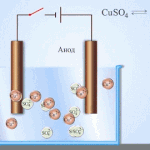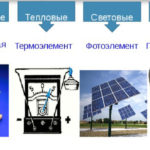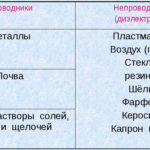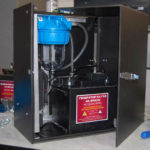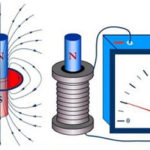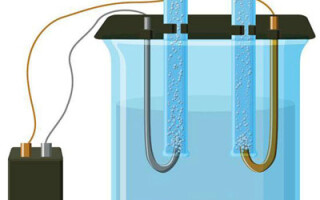The question of what electrolysis is is addressed as early as a high school physics course, and is no secret to most people. Another thing is its importance and practical application. This process is used with great benefit in various industries and can be useful for the home craftsman.
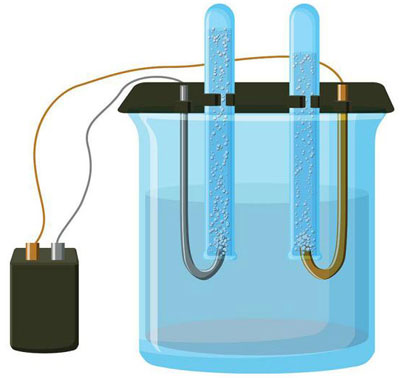
Contents
What is electrolysis?
Electrolysis is a complex of specific processes in a system of electrodes and electrolyte when a direct electric current flows through it. Its mechanism is based on the generation of an ionic current. The electrolyte is a type 2 conductor (ionic conductivity) in which electrolytic dissociation occurs. It involves decomposition into ions with positive (cation) and negative (anion) charge.
An electrolytic system necessarily contains a positive (anode) and a negative (cathode) electrode. When a direct electric current is applied, cations begin to move toward the cathode and anions move toward the anode. The cations are mainly metal ions and hydrogen, and the anions are oxygen and chlorine. At the cathode, the cations attach excess electrons to themselves, allowing the reduction reaction Men+ + ne → Me (where n is the valence of the metal). At the anode, on the contrary, electrons are given up from the anion with the oxidative reaction taking place.
Thus, the redox process is ensured in the system. It is important to keep in mind that for it to occur, the appropriate energy is required. It must be provided by an external current source.
Faraday's laws of electrolysis
The great physicist M. Faraday, through his research, made it possible not only to understand the nature of electrolysis, but also to make the necessary calculations for its implementation. In 1832 his laws appeared, linking the main parameters of the processes taking place.
The first law
Faraday's first law states that the mass of the substance reduced on the anode is directly proportional to the electric charge induced in the electrolyte: m = kq = k*I*t, where q is the charge, k is the coefficient or electrochemical equivalent of the substance, I is the current flowing through the electrolyte, t is the time of current flow.

Second law
Faraday's second law made it possible to determine the coefficient of proportionality k. It reads as follows: the electrochemical equivalent of any substance is directly proportional to its molar mass and inversely proportional to its valence. The law is expressed as:

k = 1/F*A/zwhere F is Faraday's constant, A is the molar mass of the substance, z is its chemical valence.
Taking both laws into account, we can derive the final formula for calculating the mass of a substance deposited on the electrode: m = A*I*t/(n*F)where n is the number of electrons involved in the electrolysis. Usually n corresponds to the charge of the ion. From a practical point of view, it is important to relate the mass of the substance to the current supplied, which makes it possible to control the process by changing its strength.
Electrolysis of melts
One option for electrolysis is to use a melt as the electrolyte. In this case, only melt ions are involved in the electrolysis process. A classic example is the electrolysis of the salt melt NaCl (table salt). Negative ions rush toward the anode, which means that gas is released (Cl). At the cathode there will be metal reduction, i.e. settling of pure Na formed from positive ions that attracted excess electrons. Similarly, other metals can be produced (K, Ca, Li, etc.) from the melt of the respective salts.
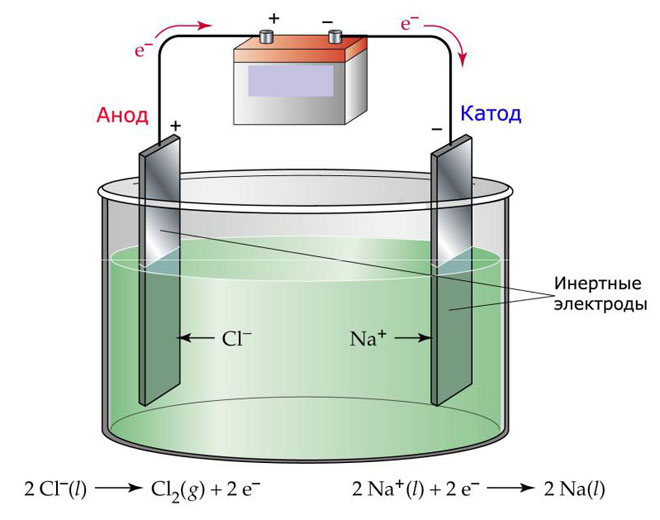
During electrolysis in the melt, the electrodes are not dissolved but participate only as a current source. Metal, graphite, and some semiconductors can be used in their manufacture. It is important that the material has sufficient conductivity. One of the most common materials is copper.
Features of electrolysis in solutions
Electrolysis in an aqueous solution is quite different from melt. There are 3 competing processes: oxidation of water with release of oxygen, oxidation of the anion and anodic dissolution of the metal. The process involves water ions, the electrolyte and the anode. Accordingly, the reduction of hydrogen, electrolyte cations, and anode metal may occur at the cathode.

The ability of these competing processes to occur depends on the electrical potentials of the system. Only the process that requires less external energy will proceed. Consequently, the cations with the maximum electrode potential will be reduced at the cathode, and the anions with the lowest potential will be oxidized at the anode. The electrode potential of hydrogen is taken as "0". For example, in potassium it is equal to (-2,93 В), sodium is equal to (-2,71 В), lead (-0,13 В), and for silver - (+0,8 В).
Electrolysis in gases
A gas can perform the role of an electrolyte only in the presence of an ionizer. In this case, a current passing through the ionized medium causes the necessary process at the electrodes. Faraday's laws do not apply to gas electrolysis. Such conditions are necessary for its realization:
- Without artificial ionization of the gas, neither high voltage nor high current will help.
- Only oxygen-free acids in a gaseous state and some gases are suitable for electrolysis.
Important! If the necessary conditions are fulfilled, the process proceeds similarly to electrolysis in a liquid electrolyte.
Peculiarities of processes occurring at the cathode and anode
For the practical application of electrolysis, it is important to understand what happens at both electrodes when an electric current is applied. The following processes are characteristic:
- Cathode. The positively charged ions rush toward it. This is where the reduction of metals or the release of hydrogen occurs. Several categories of metals can be distinguished according to their cationic activity. Metals such as Li, K, Ba, St, Ca, Na, Mg, Be, Al are well reduced only from molten salts. If a solution is used, hydrogen is released due to the electrolysis of water. It is possible to provide reduction in solution, but with a sufficient concentration of cations, in the following metals - Mn, Cr, Zn, Fe, Cd, Ni, Ti, Co, Mo, Sn, Pb. The process is easiest for Ag, Cu, Bi, Pt, Au, Hg.
- Anode. Negatively charged ions arrive at this electrode. Oxidizing them, they take electrons away from the metal, which leads to their anodic dissolution, i.e. The anions are converted into positively charged ions, which are directed toward the cathode. Anions are also subdivided according to their activity. Only PO4, CO3, SO4, NO3, NO2, ClO4, F anions can be discharged from melts. In aqueous solutions, they are not subjected to electrolysis, but water with release of oxygen. Anions such as OH, Cl, I, S, Br react most readily.

When providing electrolysis, it is important to consider the tendency of the electrode material to oxidize. In this respect, inert and active anodes are distinguished. Inert electrodes are made of graphite, coal or platinum and are not involved in the supply of ions.
Factors affecting the electrolysis process
The electrolysis process depends on the following factors:
- The composition of the electrolyte. A significant influence is exerted by various impurities. They are divided into 3 types - cations, anions and organics. Substances can be more or less negative than the base metal, which interferes with the process. Among the organic impurities are contaminants (e.g. oils) and surfactants. Their concentrations have limit values.
- Current density. According to Faraday's laws, the mass of the deposited substance increases as the current strength increases. However, unfavorable circumstances arise - concentrated polarization, increased voltage, intense heating of the electrolyte. With this in mind, there are optimal values of current density for each case.
- pH of the electrolyte. The acidity of the medium is also chosen with the metals in mind. For example, the optimum value of the acidity of the electrolyte for zinc is 140 g/cc.
- Electrolyte temperature. It has an ambiguous effect. As the temperature increases, the rate of electrolysis increases, but so does the activity of impurities. There is an optimum temperature for each process. It is usually between 38-45 degrees.
Important! Electrolysis can be accelerated or slowed down by different influences and the choice of electrolyte composition. Each application has its own mode, which should be strictly observed.
Where is electrolysis used?
Electrolysis is used in many applications. Several major uses can be identified for practical results.
Electroplating
A thin, durable galvanic coating of metal can be applied by electrolysis. The item to be coated is placed in a bath as a cathode, and the electrolyte contains a salt of the desired metal. This is how steel can be plated with zinc, chromium or tin.
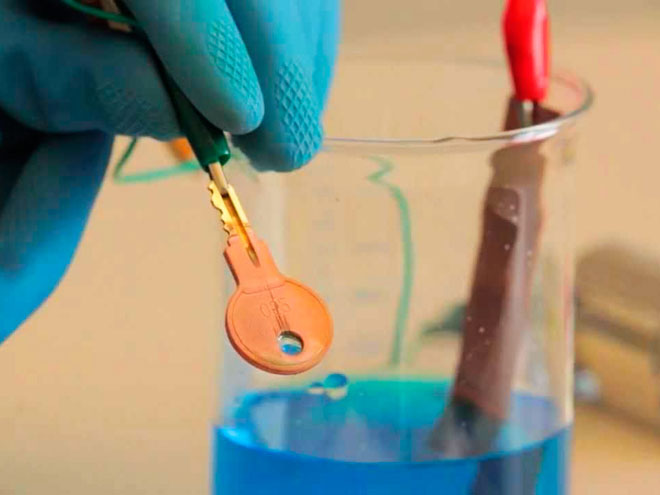
Electrotreatment - refining copper
An example of electric refining is this option: cathode - pure copper, anode - copper with impurities, electrolyte - aqueous solution of copper sulfate. Copper from the anode turns into ions and is deposited in the cathode without impurities.
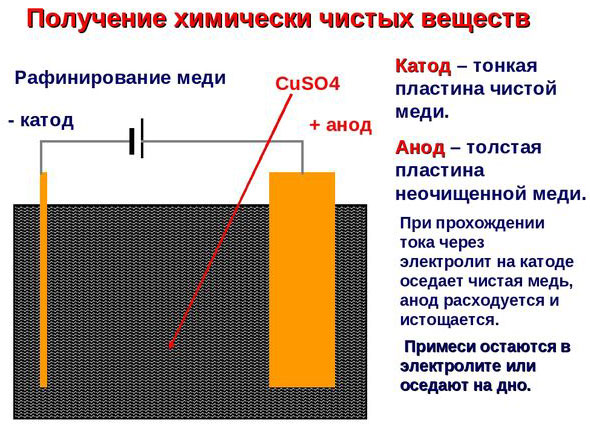
Metal extraction.
To obtain metals from salts, they are transferred into a melt and then electrolysis is provided in it. This method is quite effective for obtaining aluminum from bauxite, sodium, and potassium.

Anodizing
In this process, the coating is made from non-metallic compounds. The classic example is aluminum anodizing. The aluminum part is mounted like an anode. The electrolyte is a solution of sulfuric acid. As a result of electrolysis, a layer of aluminum oxide is deposited on the anode, which has protective and decorative properties. These technologies are widely used in various industries. It is also possible to carry out the processes with your own hands in a safe manner.
Energy costs
Electrolysis requires a great deal of energy. The process will be of practical value if the anodic current is sufficient, and for this it is necessary to apply a considerable direct current from the electric power source. In addition, it produces side voltage losses - anodic and cathodic overvoltage, losses in the electrolyte due to its resistance. The efficiency of the plant is determined by relating the power of the energy input to the unit of useful mass of the obtained substance.
Electrolysis has long been used in industry with high efficiency. Anodizing and electroplating have become commonplace in everyday life, and mining and beneficiation of materials helps to extract many metals from ore. The process can be planned and calculated by knowing its basic patterns.
Related articles:
